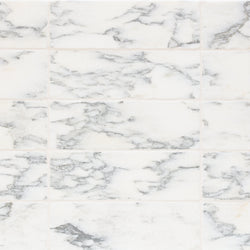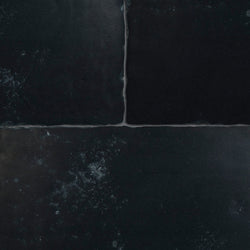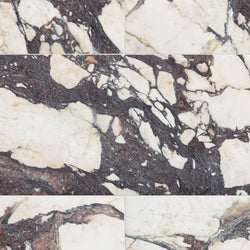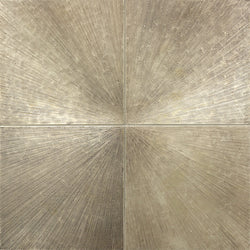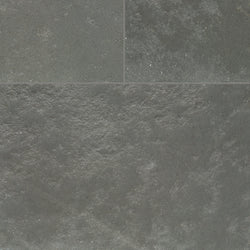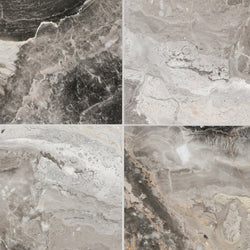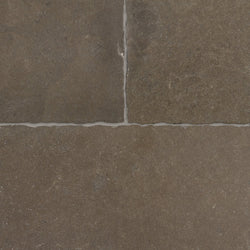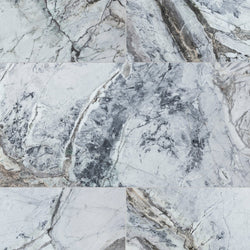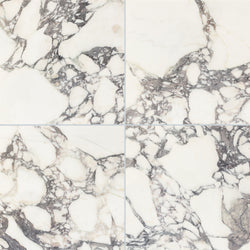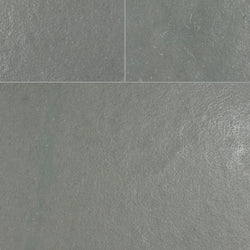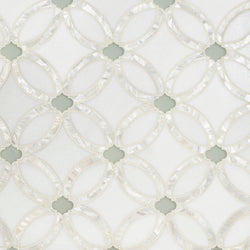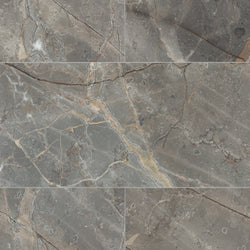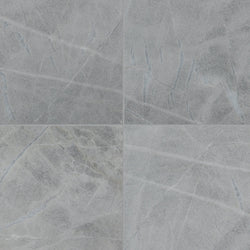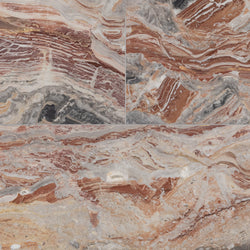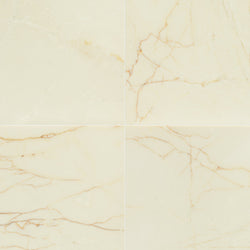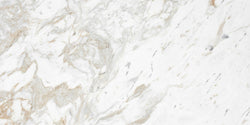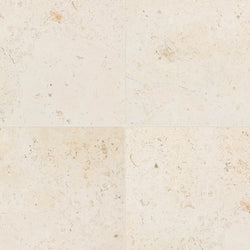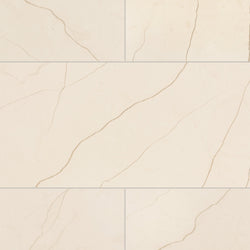
Calacatta gold marble mosaic
Diamond
Calacatta Gold
Polished
$46.00 per S/F
Browse our exquisite collection of natural stone tiles; choose from marble, limestone, and quartzite. The veining and rich colors of marble are iconic and are associated with luxury. Add warmth to your space with the earthy tones of limestone. The durability and elegance of quartzite is unmatched. Natural stone tiles can be used on floors, walls, and backsplashes. Take your kitchen or bathroom to the next level. Stone is a suitable tiling option for architects, builders, homeowners, and interior designers. Find the perfect natural stone flooring for your home or commercial space.
Natural stone tiles are an incredibly versatile and timeless choice for both floor tiles and wall tiles, offering a broad range of colors and characters that suit any design style. From polished marble to textured limestone or tumbled quartzite, these popular choices not only bring beauty and appeal to every room but also stand out as a durable, functional option for high-traffic areas and wet areas like showers. Proper sealing ensures stone flooring remains easy to maintain and retains its classic aesthetic, whether installed indoors or outdoors. With various patterns available, from traditional layouts to modern designs, stone tiles can improve the appearance of countertops, backsplashes, and other projects.
Natural stone tile represents a classic material choice with roots in architectural construction dating back hundreds of years. During production, this material involves the cutting of natural stones such as limestone, granite, or marble into slender slices that serve as flooring or wall coverings. Natural stone tiles provide distinctive room aesthetics through their earth-derived colors and patterns that have developed over millennia—qualities not found in synthetic options. Natural stone surfaces appear in many rock types and receive frequent acclaim for their elegant appearance and luxurious ambiance in interior spaces. The seamless integration of this material with both traditional and modern design elements makes it a favorite among homeowners and design professionals.
Marble natural stone tiles often appear in areas that require refined aesthetics. They display striking veins and come in shades such as white, gray, and yellow. Professionals polish marble regularly to maintain its surface, making it a preferred choice for residential projects.
For a softer material option, limestone is a reliable choice. It appears in lighter tones while maintaining a traditional aesthetic. Proper sealing protects limestone surfaces from stains in areas with heavy foot traffic.
Travertine is popular for those seeking a rustic look for floors and walls. Its natural pores can be filled or left open to create a textured finish, making it ideal for kitchens and walkways when properly maintained.
Granite is a robust option where durability is a priority. Stone slabs are often used on heavily used countertops, as granite tiles maintain their appearance even in high-traffic areas.
Admired for its translucent character, onyx is commonly used on accent walls and decorative partitions to create focal points. Its unique appearance lends a distinctive atmosphere to any space.
The honed finish produces a smooth texture without a reflective shine. Many homeowners prefer honed stone floors for their subdued look.
When granite and marble are polished, their natural color differences become more vivid, creating a glossy effect through light reflection.
Tumbled tiles have a softly worn appearance achieved during processing. Tumbled travertine or marble tiles provide an aged look that many find appealing.
Some designs combine multiple finishes to create contrast, using sections that are partially honed and partially polished.
Textured tiles involve brushing or special etching to enhance grip in moist environments, such as shower areas or poolside settings.
The leather finish, achieved by brushing the surface to form a slight ripple with soft ridges, is sometimes seen on granite or slate tiles.
Brushing reveals fine ridges in materials like sandstone and limestone, similar to the leather finish, offering a distinct underfoot texture.
Antiqued tiles are treated to appear older, perfect for creating a classic or traditional theme.
A natural stone mosaic tile arrangement can transform a small area—such as a backsplash—into a striking focal point. Mosaic layouts often display multiple cuts of stone, including slate, travertine, or onyx.
Dimensional tiles project from the wall, allowing light and shadow to create interesting effects. They are often used around fireplaces or as accent trim.
Decorative patterns might involve geometric shapes or repeating motifs. Some designs even feature a mosaic centerpiece to accent an entryway floor.
Natural stone remains a favorite for its enduring beauty. Homeowners choose natural stone floor tiles for their classic look that lasts for years.
Materials like granite and slate withstand heavy foot traffic over time. With proper maintenance, natural stone keeps its condition even in high-use areas.
Suitable for floors, walls, fireplaces, and backsplashes, natural stone tiles can be integrated into various design schemes. Many designs incorporate natural stone mosaic accents, especially in bathrooms.
Since natural stone is quarried directly from the earth with minimal processing, it is a sustainable choice for environmentally conscious projects.
Ideal for kitchens, living rooms, and entryways, natural stone floor tiles maintain their appeal in high-traffic areas when properly sealed.
Often chosen for accent walls in dramatic entry halls or lounges, natural stone wall tiles can also frame fireplaces to add warmth to the area.
Regular maintenance is key to preserving the beauty of natural stone tiles. Due to the porosity of some stone types, sealing is necessary to prevent staining. In damp areas such as showers, applying sealant routinely helps maintain the tiles' appearance.
While porcelain can mimic the look of natural stone, it is factory-made and often lacks the authentic character of genuine stone.
Ceramic tiles are typically more uniform. Being man-made, they do not exhibit the unique variations found in natural stone such as marble, travertine, or limestone.
Natural stone tile is a timeless choice in residential design. Slate, travertine, marble, and other stone tiles each come from distinct rock types, offering unique patterns and hues. For countertops, stone slabs are usually recommended over tiles. However, for flooring or wall applications, the rustic charm of natural stone makes a lasting impression. At Artistic Tile, explore our extensive collection of stone tiles to discover the perfect selection to bring your design ideas to life!
Some natural stone types are more porous, making them more susceptible to spills and stains.
Generally, natural stone costs more than basic porcelain or ceramic, but many find its unique beauty and authenticity worth the investment.
Without sealing, natural stone tiles may absorb water or oils, leading to stains or discoloration.
Yes, natural stone tiles can be used in a shower, but sealing is crucial to prevent moisture penetration.
The frequency depends on the stone type and usage. High-traffic areas may require sealing once or twice a year, while low-traffic areas such as backsplashes or bathrooms might be sealed every two to five years.
Genuine natural stone often shows irregular veins, subtle color shifts, and unique textures. They also tend to be heavier and may feature surface imperfections like saw marks or rough edges.
Natural stone can be slippery—especially when polished. Using textured finishes or mats can help mitigate this risk.
Yes, without proper sealing or prompt cleaning after spills, natural stone tiles can stain.
Many homeowners find that the long-lasting beauty and authentic appeal of natural stone make it a worthwhile investment.
Cast stone is man-made from cement mixes, whereas natural stone is quarried from blocks or slabs.
Diamond
Calacatta Gold
Polished
$46.00 per S/F
Broken Joint 1.0cm
Calacatta Gold
Honed
$53.00 per S/F
Broken Joint 3.0cm
Calacatta Gold
Honed
$43.00 per S/F
Hexagon 3.0cm
Calacatta Gold
Honed
$48.00 per S/F
Straight Joint 1.5cm
Calacatta Gold
Honed
$43.00 per S/F
Broken Joint 3.0cm
Calacatta Gold
Polished
$43.00 per S/F
1x3" Chevron
Calacatta Gold
Polished
$48.00 per S/F
Hexagon 3.0cm
Calacatta Gold
Polished
$48.00 per S/F
Straight Joint 1.5cm
Calacatta Gold
Polished
$43.00 per S/F
Straight Joint 3.0cm
Calacatta Gold
Polished
$42.00 per S/F
4" X 12" X 3/8"
Arabescato
Tumbled
$39.00 per S/F
4" X 12" X 3/8"
Balkan Beige
Tumbled
$30.00 per S/F
4" X 12" X 3/8"
Bianco Carrara
Tumbled
$24.00 per S/F
4" X 12" X 3/8"
Nero Marquina
Tumbled
$33.00 per S/F
4" X 12" X 3/8"
Smoke
Tumbled
$26.00 per S/F
4" X 12" X 3/8"
Thassos
Tumbled
$46.00 per S/F
4" X 12" X 3/8"
Calacatta Rosa
Tumbled
$27.00 per S/F
4" X 12" X 3/8"
Rosa Portogallo
Tumbled
$39.00 per S/F
12" X 24" X 3/8"
Bianco Carrara
Tumbled
$35.00 per S/F
12" X 24" X 3/8"
Nero Marquina
Tumbled
$45.00 per S/F
12" X 24" X 3/8"
Smoke
Tumbled
$35.00 per S/F
12" X 24" X 3/8"
Brunetta
Tumbled
$40.00 per S/F
12" X 24" X 3/8"
Sabbia
Tumbled
$45.00 per S/F
24" X 3" X 3/8" Chevron
Bianco Carrara
Tumbled
$35.00 per S/F
24" X 3" X 3/8" Chevron
Nero Marquina
Tumbled
$45.00 per S/F
24" X 3" X 3/8" Chevron
Smoke
Tumbled
$35.00 per S/F
24" X 3" X 3/8" Chevron
Brunetta
Tumbled
$40.00 per S/F
24" X 3" X 3/8" Chevron
Sabbia
Tumbled
$35.00 per S/F
12" X 24" X 3/8"
Rosa Portogallo
Tumbled
$42.00 per S/F
12" X 24" X 3/8"
Calacatta Rosa
Tumbled
$30.00 per S/F
24" X 3" X 3/8" Chevron
Rosa Portogallo
Tumbled
$46.00 per S/F
24" X 3" X 3/8" Chevron
Calacatta Rosa
Tumbled
$35.00 per S/F
4" X 12" X 3/8"
Cloud
Tumbled
$26.00 per S/F
4" X 12" X 3/8"
Vanilla
Tumbled
$60.00 per S/F
Broken Joint 1.0cm
Bianco Dolomiti
Honed
$48.00 per S/F
Broken Joint 3.0cm
Bianco Dolomiti
Polished
$39.00 per S/F
Hexagon 3.0cm
Bianco Dolomiti
Polished
$42.00 per S/F
Straight Joint 1.5cm
Bianco Dolomiti
Polished
$38.00 per S/F
1x3" Chevron
Bianco Dolomiti
Polished
$45.00 per S/F
11-7/8" X 12-7/16" X 3/8"
Bianco Dolomiti
Honed
$48.00 per S/F
11-7/8" X 12-7/16" X 3/8"
Nero
Honed
$38.00 per S/F
11-7/8" X 12-7/16" X 3/8"
Calacatta Gold
Honed
$48.00 per S/F
11-7/8" X 12-7/16" X 3/8"
Vanilla
Honed
$53.00 per S/F
11-7/8" X 12-7/16" X 3/8"
White Sand
Honed
$40.00 per S/F
11-7/8" X 12-7/16" X 3/8"
Arabescato D'oro
Honed
$45.00 per S/F
12-7/16" X 11-7/8" X 1/2"
Noir
Antiqued
$28.00 per S/F
12-7/16" X 11-7/8" X 1/2"
Sea Grey
Antiqued
$28.00 per S/F
11-7/8" X 12-7/16" X 3/8"
Birch White
Honed
$50.00 per S/F
11-7/8" X 12-7/16" X 3/8"
Viola Reale
Honed
$50.00 per S/F
11-7/8" X 12-7/16" X 3/8"
Rosa Minerva
Honed
$45.00 per S/F
12" X 12" X 3/8"
Bianco Carrara/Bronze
Textured
$115.00 per S/F
12" X 12" X 3/8"
Bianco Carrara
Textured
$65.00 per S/F
12" X 12" X 3/8"
Smoke/Silver
Textured
$115.00 per S/F
12" X 12" X 3/8"
Verde/Silver
Textured
$125.00 per S/F
Broken Joint 3.0cm
Thassos
Polished
$42.00 per S/F
1x3" Chevron
Thassos
Polished
$50.00 per S/F
Hexagon 3.0cm
Thassos
Polished
$57.00 per S/F
Straight Joint 1.5cm
Thassos
Polished
$45.00 per S/F
Straight Joint 3.0cm
Thassos
Polished
$42.00 per S/F
12" X 24" X 3/8"
Lilac
Honed
$23.00 per S/F
24" X 24" X 3/8"
Lilac
Honed
$26.00 per S/F
4" X 12" X 3/8"
Lilac
Honed
$16.00 per S/F
12" X 24" X 3/8"
Lilac Dark
Honed
$21.00 per S/F
12" X 24" X 3/8"
Azul Cielo
Honed
$52.00 per S/F
12" X 12" X 3/8"
Azul Cielo
Polished
$45.00 per S/F
Roman Antiqued 16" x 24" x 5/8" Stone Chiseled Edge
$30.00 per S/F
Honed 12" x 24" x 3/8" Stone Aris Edge
$67.00 per S/F
Metallic Stone
$90.00 per S/F
12" X 24" X 3/8"
Cloud
Deep Brushed
$26.00 per S/F
18" X 36" X 3/8"
Cloud
Deep Brushed
$30.00 per S/F
24" X 24" X 3/8"
Cloud
Deep Brushed
$28.00 per S/F
Roman Antiqued 16" x 24" x 5/8" Stone Chiseled Edge
$30.00 per S/F
12" X 24" X 3/8"
Bianco Dolomiti Standard
Honed
$39.00 per S/F
12" X 24" X 3/8"
Bianco Dolomiti Standard
Polished
$39.00 per S/F
12" X 24" X 3/8"
Bianco Dolomiti Extra
Polished
$54.00 per S/F
12" X 24" X 3/8"
Bianco Dolomiti Select
Honed
$47.00 per S/F
24" X 24" X 3/8"
Bianco Dolomiti Select
Honed
$86.00 per S/F
4" X 12" X 3/8"
Bianco Dolomiti A1 Select
Honed
$33.00 per S/F
4" X 4" X 3/8"
Bianco Dolomiti
Honed
$47.00 per S/F
12" X 24" X 3/8"
Bianco Dolomiti Select
Polished
$47.00 per S/F
18" X 36" X 3/8"
Bianco Dolomiti Select
Polished
$87.00 per S/F
4" X 12" X 3/8"
Bianco Dolomiti A1 Select
Polished
$33.00 per S/F
Straight Edge
Odessa Black Belgian Bluestone
18" X 18" X 3/8"
$35.00 per S/F
Chiseled Edge
Odessa Black Belgian Bluestone
18 X 18 X 3/8"
$35.00 per S/F
Metallic Stone
$90.00 per S/F
Broken Joint 1.0cm
Calacatta Bluette
Honed
$51.00 per S/F
Hexagon 3.0cm
Calacatta Bluette
Honed
$51.00 per S/F
6" X 12" X 3/8"
Nero
Honed
$120.00 per S/F
6" X 12" X 3/8"
Thassos
Honed
$130.00 per S/F
12" X 24" X 3/8"
Arabescato D'oro
Honed
$95.00 per S/F
12" X 24" X 3/8"
Lilac
Honed
$95.00 per S/F
12" X 24" X 3/8"
Vanilla
Honed
$130.00 per S/F
12" X 24" X 3/8"
Nero Dorato
Honed
$95.00 per S/F
Honed 12" x 24" x 3/8" Stone Aris Edge
$40.00 per S/F
Polished 18" x 18" x 3/8" Stone Aris Edge
$65.00 per S/F
12" X 24" X 3/8"
Bianco Carrara
Textured
$62.00 per S/F
12" X 24" X 3/8"
Grey Foussana
Textured
$62.00 per S/F
12" X 24" X 3/8"
Smoke
Textured
$62.00 per S/F
12" X 24" X 3/8"
Lilac
Textured
$62.00 per S/F
12" X 24" X 3/8"
Belgian Bluestone
Textured
$62.00 per S/F
12" X 24" X 3/8"
Belgian Bluestone
Honed
$29.00 per S/F
24" X 24" X 3/8"
Belgian Bluestone
Honed
$32.00 per S/F
24" X 24" X 5/8"
Bianco Carrara
Mixed Finish
$115.00 per S/F
24" X 24" X 5/8"
Gris
Mixed Finish
$65.00 per S/F
24" X 24" X 5/8"
Moss Green
Mixed Finish
$65.00 per S/F
24" X 24" X 5/8"
Lake Blue
Mixed Finish
$65.00 per S/F
Honed 12" x 24" x 3/8" Stone Aris Edge
$32.00 per S/F
12" X 24" X 3/8"
Calacatta Rosa
Honed
$29.00 per S/F
24" X 24" X 3/8"
Calacatta Rosa
Polished
$38.00 per S/F
Polished 12" x 24" x 3/8" Stone Aris Edge
$42.00 per S/F
9" X 18" X 3/8"
Bianco Carrara
Textured
$48.00 per S/F
9" X 18" X 3/8"
Grey Foussana
Textured
$48.00 per S/F
9" X 18" X 3/8"
Smoke
Textured
$48.00 per S/F
9" X 18" X 3/8"
Thassos
Textured
$75.00 per S/F
9" X 18" X 3/8"
Belgian Bluestone
Textured
$52.00 per S/F
$372.00 each
Roman Antiqued 16" x 24" x 5/8" Stone Chiseled Edge
$31.00 per S/F
6" X 16" X 3/8"
Gold
Metallic
$110.00 per S/F
6" X 16" X 3/8"
Silver
Metallic
$110.00 per S/F
Honed 12" x 24" x 3/8" Stone
$31.00 per S/F
24" X 24" X 3/8"
Viola Reale Select
Honed
$48.00 per S/F
12" X 24" X 3/8"
Viola Reale Classico
Honed
$22.00 per S/F
18" X 18" X 3/8"
Noir Moon
Honed
$28.00 per S/F
12" X 24" X 3/8"
Noir Moon
Polished
$23.00 per S/F
12" X 24" X 3/8"
Noir Moon
Honed
$25.00 per S/F
18" X 18" X 3/8"
Noir Moon
Polished
$30.00 per S/F
12" X 24" X 3/8"
Pacific White
Honed
$40.00 per S/F
12" X 24" X 3/8"
Pacific White
Polished
$40.00 per S/F
3" X 6" X 3/8"
Pacific White
Polished
$25.00 per S/F
6" X 12" X 3/8"
Pacific White
Polished
$25.00 per S/F
12" X 24" X 3/8"
Calacatta Gold
Honed
$60.00 per S/F
18" X 18" X 3/8"
Calacatta Gold
Honed
$70.00 per S/F
24" X 24" X 3/8"
Calacatta Gold
Honed
$100.00 per S/F
6" X 12" X 3/8"
Calacatta Gold
Honed
$45.00 per S/F
12" X 24" X 3/8"
Calacatta Gold
Polished
$60.00 per S/F
18" X 18" X 3/8"
Calacatta Gold
Polished
$70.00 per S/F
24" X 24" X 3/8"
Calacatta Gold
Polished
$100.00 per S/F
3" X 6" X 3/8"
Calacatta Gold
Polished
$39.00 per S/F
6" X 12" X 3/8"
Calacatta Gold
Polished
$45.00 per S/F
18" X 18" X 3/8"
Breccia Vino
Polished
$41.00 per S/F
12" X 24" X 3/8"
Breccia Vino
Honed
$35.00 per S/F
12" X 24" X 3/8"
Bardiglio Imperiale
Honed
$33.00 per S/F
18" X 18" X 3/8"
Bardiglio Nuvolato
Polished
$28.00 per S/F
18" X 18" X 3/8"
Bardiglio Imperiale
Roman Antiqued
$32.00 per S/F
24" X 24" X 3/8"
Bardiglio Nuvolato
Honed
$35.00 per S/F
Honed 12" x 24" x 3/8" Stone Aris Edge
$58.00 per S/F
Polished 18" x 18" x 3/8" Stone Aris Edge
$90.00 per S/F
Honed 24" x 24" x 3/8" Stone Aris Edge
$35.00 per S/F
Honed 12" x 24" x 3/8" Stone Aris Edge
$31.00 per S/F
Rustic 16" x 24" x 5/8" Stone Straight Edge
$26.00 per S/F
Honed 18" x 18" x 3/8" Stone Straight Edge
$20.00 per S/F
Mixed Finish Stone
$225.00 per S/F
Honed 12" x 24" x 1/2" Stone Straight Edge
$46.00 per S/F
High Honed 12" x 24" x 3/8" Stone
$55.00 per S/F
12" X 24" X 3/8"
Calacatta Borghini
Honed
$57.00 per S/F
12" X 24" X 3/8"
Calacatta Borghini
Polished
$57.00 per S/F
4" X 12" X 3/8"
Calacatta Borghini
Honed
$47.00 per S/F
4" X 12" X 3/8"
Calacatta Borghini
Polished
$47.00 per S/F
$540.00 each
Polished 18" x 18" x 1/2" Stone Aris Edge
$72.00 per S/F
High Honed 16" x 24" x 3/8" Stone Aris Edge
$49.00 per S/F
18" X 18" X 3/8"
Macael White
Honed
$35.00 per S/F
18" X 18" X 3/8"
Macael Grey
Honed
$35.00 per S/F
18" X 18" X 3/8"
Portobello
Honed
$31.00 per S/F
4" X 12" X 3/16"
Rosso Francia
Mixed Finish
$138.00 per S/F
12" X 24" X 3/8"
Rosso Francia
Honed
$85.00 per S/F
8-3/16" X 8-3/16" X 3/8"
Lilac
Honed
$40.00 per S/F
8-3/16" X 8-3/16" X 3/8"
Red Travertine
Honed
$40.00 per S/F
$450.00 each
$560.00 each
8" X 16" X 3/8"
Volakas White
Honed
$140.00 per S/F
8" X 16" X 3/8"
Nero
Honed
$135.00 per S/F
8" X 16" X 3/8"
Sea Grey
Honed
$130.00 per S/F
Polished 12" x 24" x 3/8" Stone
$26.00 per S/F
12" X 24" X 3/8"
Grigio Toscana
Textured
$52.00 per S/F
12" X 24" X 3/8"
Belgian Bluestone
Textured
$57.00 per S/F
12" X 24" X 3/8"
Verde
Textured
$60.00 per S/F
Honed 18" x 32" x 9/16" Stone Straight Edge
$33.00 per S/F
Polished Stone Hexagon 3.0cm
$35.00 per S/F
Honed Stone Straight Joint 3.0cm
$66.00 per S/F
Honed 18" x 18" x 3/8" Stone Aris Edge
$36.00 per S/F
12" X 24" X 1/2"
White Sand
Honed
$31.00 per S/F
12" X 24" X 1/2"
White Sand
Polished
$31.00 per S/F
24" X 24" X 1/2"
White Sand
Polished
$37.00 per S/F
24" X 48" X 5/8"
White Sand
Honed
$55.00 per S/F
24" X 24" X 1/2"
White Sand
Honed
$36.00 per S/F
4" X 12" X 3/16"
Arabescato
Textured
$72.00 per S/F
4" X 12" X 3/16"
Grafite
Textured
$80.00 per S/F
12" X 24" X 3/8"
Rosa Portogallo
Honed
$45.00 per S/F
12" X 24" X 3/8"
Rosa Portogallo
Polished
$45.00 per S/F
Honed 12" x 24" x 3/8" Stone Aris Edge
$50.00 per S/F
Honed 12" x 24" x 3/8" Stone Aris Edge
$35.00 per S/F
16" X 16" X 3/8"
Nero
Carved
$125.00 per S/F
16" X 16" X 3/8"
Bianco Carrara
Carved
$125.00 per S/F
12" X 24" X 3/8"
Bianco Carrara
Mixed Finish
$120.00 per S/F
12" X 24" X 3/8"
China Black
Mixed Finish
$120.00 per S/F
12" X 24" X 3/8"
Bardiglio Nuvolato
Textured
$120.00 per S/F
Honed 12" x 24" x 3/8" Stone
$52.00 per S/F
Honed 12" x 24" x 3/8" Stone Aris Edge
$23.00 per S/F
Leather 12" x 24" x 3/8" Stone Aris Edge
$35.00 per S/F
$540.00 each
Honed 18" x 18" x 3/8" Stone Aris Edge
$58.00 per S/F
Honed 12" x 24" x 3/8" Stone Aris Edge
$42.00 per S/F
Honed 12" x 24" x 3/8" Stone Aris Edge
$32.00 per S/F
11-5/8" X 11-5/8" X 3/8"
Rosa
Honed
$150.00 per S/F
11-5/8" X 11-5/8" X 3/8"
Bardiglio
Mixed Finish
$120.00 per S/F
11-5/8" X 11-5/8" X 3/8"
Green
Honed
$125.00 per S/F
Vein Cut Filled Honed 16" x 32" x 3/8" Stone Aris Edge
$28.00 per S/F
Vein Cut Filled Honed/Filled 12" x 24" x 3/8" Stone Straight Edge
$26.00 per S/F
18-7/16" X 20-5/16" X 3/8"
White
Mixed Finish
$220.00 per S/F
18-7/16" X 20-5/16" X 3/8"
Black
Mixed Finish
$220.00 per S/F
Hexagon
Bianco Carrara
Mixed Finish
$57.00 per S/F
Hexagon
Nero Italia
Mixed Finish
$65.00 per S/F
6" X 12" X 3/8"
Smoke
Textured
$98.00 per S/F
6" X 12" X 3/8"
Bianco Antico
Textured
$98.00 per S/F
16" X 16" X 1/2"
Nero
Honed
$130.00 per S/F
16" X 16" X 1/2"
Volakas White
Honed
$135.00 per S/F
16" X 16" X 1/2"
Moca Cream
Honed
$130.00 per S/F
12" X 24" X 3/8"
Jerusalem Pearl
Mixed Finish
$37.00 per S/F
12" X 24" X 3/8"
Thassos
Mixed Finish
$55.00 per S/F
12" X 24" X 3/8"
Lilac
Mixed Finish
$32.00 per S/F
12" X 24" X 1/2"
White Sand
Mixed Finish
$36.00 per S/F
Honed 16" x 24" x 3/8" Stone Straight Edge
$21.00 per S/F
12" X 24" X 3/8"
Grey Foussana
Honed
$29.00 per S/F
18" X 36" X 3/8"
Grey Foussana
Honed
$32.00 per S/F
22- 15/16" X 21-5/8" X 11/16"
Bianco Carrara
Mixed Finish
$191.00 per S/F
22- 15/16" X 21-5/8" X 11/16"
Grey Foussana
Mixed Finish
$191.00 per S/F
16" X 16" X 1/2"
Sea Grey
Polished
$110.00 per S/F
16" X 16" X 3/8"
Thassos
Polished
$130.00 per S/F
16" X 16" X 3/8"
Nero
Honed
$125.00 per S/F
12" X 24" X 1"
Bianco Carrara
Mixed Finish
$205.00 per S/F
12" X 24" X 1"
Smoke
Mixed Finish
$230.00 per S/F
Honed 18" x 18" x 3/8" Stone Aris Edge
$28.00 per S/F
Roman Antiqued 18" x 18" x 3/8" Stone Chiseled Edge
$35.00 per S/F
Honed 12" x 24" x 3/8" Stone
$41.00 per S/F
24" X 48" X 11/32"
Cream
Semi-Polished
$16.00 per S/F
24" X 48" X 11/32"
Sand
Semi-Polished
$16.00 per S/F










